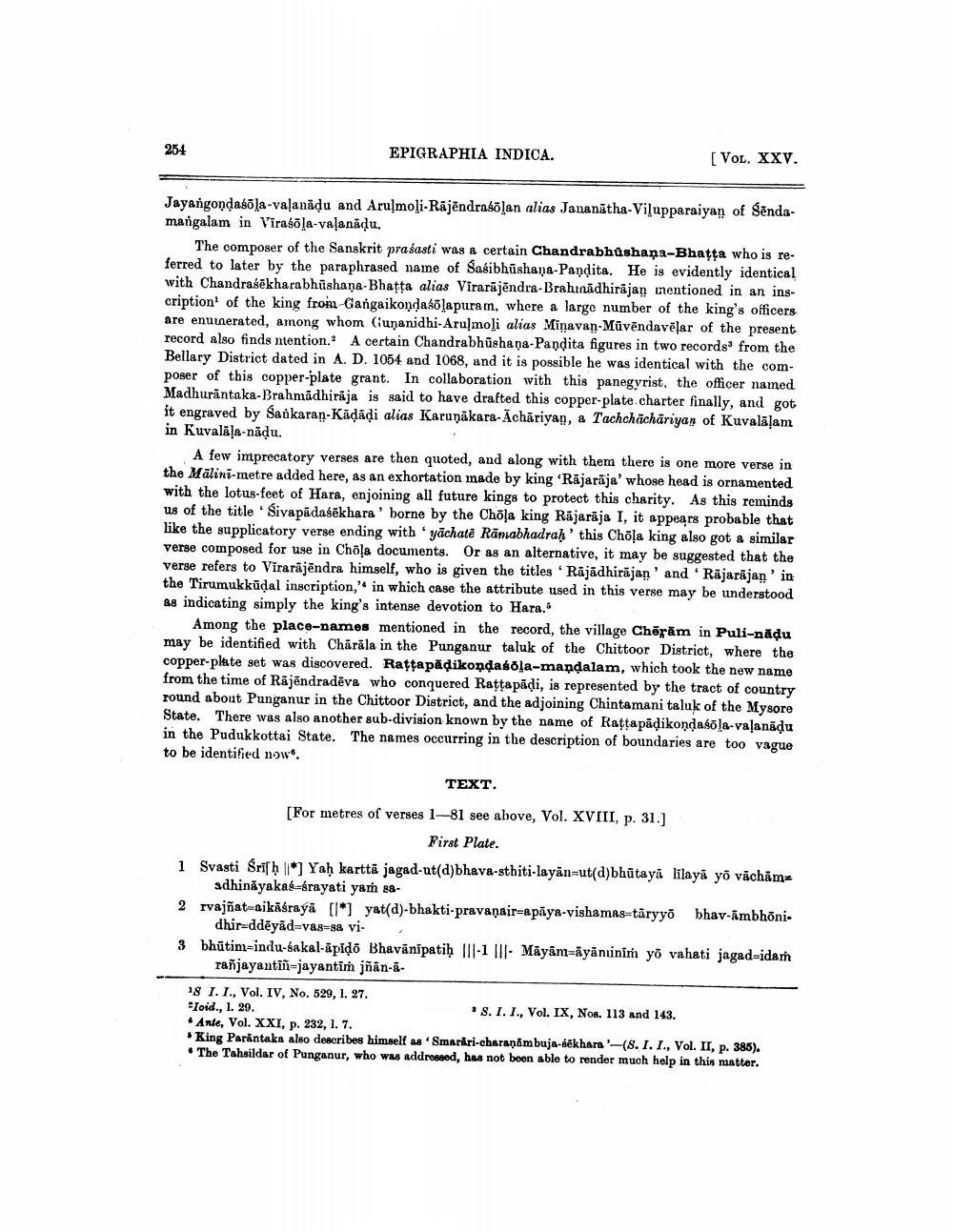________________
254
EPIGRAPHIA INDICA.
[VOL. XXV.
Jayangondasāļa-vaļanādu and Arulmoli-Rājēndrasolan alias Jananātha-Vilupparaiyan of Sēndamangalam in Virasola-vaļanadu.
The composer of the Sanskrit prasasti was a certain Chandrabhushana-Bhatta who is referred to later by the paraphrased name of Sasibhūshaņa-Pandita. He is evidently identical with Chandrasēkharabhushana-Bhatta alias Virarājēndra-Brahınādhirajan mentioned in an inscription of the king from Gangaikondasolapuram, where a large number of the king's officers are enumerated, among whom (unanidhi-Aru!moli alias Minavan-Mūvēndavēlar of the present record also finds ntention. A certain Chandrabhūshana-Pandita figures in two records from the Bellary District dated in A. D. 1054 and 1068, and it is possible he was identical with the composer of this copper-plate grant. In collaboration with this panegyrist, the officer named Madhurântaka-Brahmädhiraja is said to have drafted this copper-plate.charter finally, and got it engraved by Sankaran-Kādāļi alias Karunākara-Achăriyan, a Tachchachariyan of Kuvalālam in Kuvalāļa-nadu.
A few imprecatory verses are then quoted, and along with them there is one more verse in the Mālini-metre added here, as an exhortation made by king 'Rajarāja' whose head is ornamented with the lotus-feet of Hara, enjoining all future kings to protect this charity. As this reminds us of the title 'Sivapādaśēkhara' borne by the Chola king Rājarāja I, it appears probable that like the supplicatory verse ending with yāchatē Rāmabhadrah' this Choļa king also got a similar verse composed for use in Cho!a documents. Or as an alternative, it may be suggested that the verse refers to Virarājēndra himself, who is given the titles Rājādhirajan' and 'Rājarājanin the Tirumukkūdal inscription, in which case the attribute used in this verse may be understood as indicating simply the king's intense devotion to Hara.
Among the place-names mentioned in the record, the village Chörăm in Puli-nädu may be identified with Chārāla in the Punganur taluk of the Chittoor District, where the copper-plate set was discovered. Rattapadikondasola-mandalam, which took the new name from the time of Rājēndradēva who conquered Rattapādi, is represented by the tract of country round about Punganur in the Chittoor District, and the adjoining Chintamani taluk of the Mysore State. There was also another sub-division known by the name of Rattapādikondasola-vaļanādu in the Pudukkottai State. The names occurring in the description of boundaries are too vague to be identified now.
TEXT.
[For metres of verses 1-81 see above, Vol. XVIII, p. 31.)
First Plate. 1 Svasti Srish ] Yah karttä jagad-ut(a)bhava-sthiti-layan=ut(d)bhūtayī lilayā yo vāchăm
adhināyakas-srayati ya 882 rvajñat=aikāśraya [l*] yat(d)-bhakti-pravaņair=apāya-vishamas tāryyo bhav-āmbhõni
dhir-dděyād=vas sa vi3 bhūtim-indu-bakal-apido Bhavānipatih III-1 lll. Māyān=āyānuinin yö vahati jagad=idam
rañjayantiñ=jayantim jñān-i18 1. 1., Vol. IV, No. 529, 1. 27. "Ioid., 1. 29.
8. 1. I., Vol. IX, Nos. 113 and 143. • Ante, Vol. XXI, p. 232, 1. 7.
King Parantaka also describes himself as Smarári-charaṇambuja-sekhara'-(8.I.I., Vol. II, p. 385). • The Tahsildar of Punganur, who was addressed, has not been able to render much help in this matter.




